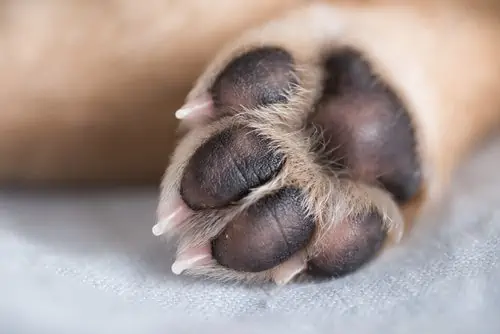
For humans, the chill of winter often means chapped, cracked skin. Unsurprisingly, it can also cause paw problems for our dogs as they pad their way through freezing ice and snow. To ensure winter walkies are enjoyable, your faithful friend’s four paws need extra special attention to prevent painful problems developing.
Paws for thought
Here are cold weather hazards to be aware of:
Anti-freeze: Dogs find this toxic blend of ethylene glycol sweet and irresistible and, if any ends up on their paws, they will lick it and ingest it. What’s more, it doesn’t take much of this lethal stuff to do some serious damage. Less than three ounces (88 ml) of antifreeze is sufficient to poison a medium-sized dog, affecting the brain, liver, and kidneys.
Rock salt: De-icing salt is used on pavements and roads to lower the freezing point of water, making them safer to walk and drive on. As well as as sodium chloride, rock salt contains small amounts of a clay-like substance called marl, along with anti-caking agents. Salt irritates paws and dogs will attempt to remove it by licking it off. Ingestion can result in a high blood sodium concentration which can cause thirst, vomiting and lethargy. In severe cases, there can be a risk of convulsions and kidney damage. If you suspect your dog has ingested rock salt, take them straight to the vet.
Ice-balls: These can form from compacted snow between the pads and toes of a dog’s feet and are very painful, potentially leading to ice burns. If your dog appears lame on a snowy day, ice balls could be the cause. Trimming the hair around your dog’s paws (see below) will help to prevent them. If they occur, wash your dog’s feet in warm water to gently remove them.
Frostbite: This can occur in the paws and other extremities, such as the tips of ears and tail, when dogs are walked outside for long periods of time when it is very cold. The skin will become very pale, due to a lack of blood flow. When the body part is warmed and blood flow returns, the skin becomes red and will swell and peel. To aid recovery, gently apply a warm towel or tepid water (32°C). If the affected area becomes dark instead of red, seek immediate veterinary attention. If you find your dog is lifting their paws up, crying, or wanting to stop, it’s likely that their feet are just too cold and it’s time to head home. While many dogs love playing in the snow, always be mindful of your dog’s comfort and limit the amount of time spent outdoors when it’s freezing.
Feet first
Top tips to keeping your dog’s paws happy and healthy this winter
- First, carefully trim away any long hair between your dog’s pads, as this will prevent uncomfortable ice balls forming around them.
- Next, apply a thin layer of Vaseline or specially designed paw balm, such as Pet Therapy Nose and Paw Balm , to protect their pads and prevent cracking.
- When you get home from your walk, wash your dog’s paws, giving the areas between their toes special attention, and dry them carefully. Then add a little more balm to each foot, to keep the pads supple.
It’s snow joke
What about investing in a pair of cute dog snow booties? Burgess in-house vet, Dr Suzanne Moyes, advises: “Most healthy dogs don’t need special winter shoes as long as winter paw care is followed. In fact, poorly fitting shoes may rub, causing injury rather than preventing it. If you are concerned about protecting your dog’s feet in winter, it’s best to have a chat with your vet who will be able to give you tailored advice about what options are available.”
Sources: dogstrust.org.uk, bluecross.org.uk, petmd.com, thewayofthedog.co.uk, news.nationalgeographic.com, saltassociation.co.uk














